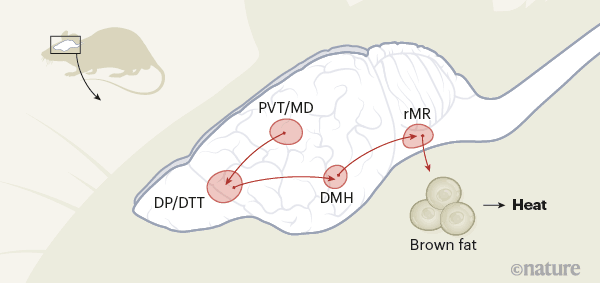Psychological stress can cause physiological responses, including fever.
Researchers identified a neural circuit in rats that underlies stress-induced physiological responses, including increased body temperature, increased heart rate, and increased blood pressure.
The key structures involved in this circuit include:
- The paraventricular thalamic nuclei, which are highly sensitive to various physical and psychological stressors, such as predator cues and pain.
- The mediodorsal thalamic nuclei, which interacts with the prefrontal cortex cortex to mediate complex cognitive functions.
- The PVT and MD project a region called the dorsal peduncular cortex and dorsal taenia tecta (DP/DTT), regions that project the dorsomedial hypothalamus to rostral medullary raphe.
- The rostral medullary raphe connects to brown fat, resulting in and increase in heat production in the brown fat, inducing fever.
The article also suggests that the behavioral manifestation of fear, or perhaps the perception of fear, depends on the bodily responses to that threat. For example, it is not the bear that causes the fear, but the running away from the bear that causes it. This is why taking a deep breath before speaking in front of an audience, or using stress reduction techniques in moments of fear, could help to alleviate the psychological, and the physiological, stress of it all.

Figure 1 | Stressful connections. Kataoka et al.3 report that, in rats, a brain region called the dorsal peduncular cortex and dorsal taenia tecta (DP/DTT) is involved in psychogenic fever — an increase in body temperature in response to social stress. Stress-related information reaches the DP/DTT from two other brain regions: the paraventricular (PVT) and mediodorsal (MD) thalamic nuclei. Neurons from the DP/DTT then project to and excite neurons in the brain’s dorsomedial hypothalamus (DMH), which in turn sends neuronal projections to the rostral medullary raphe (rMR). Finally, neurons from this region connect indirectly to brown fat tissue, which generates heat.
To read the article- visit https://www.nature.com/articles/d41586-020-00873-0
For more tips on how to reduce stress, visit our previous blog post on stress management here.
#carricktrained #carrickinstitute #carrick #COVID19 #stress



